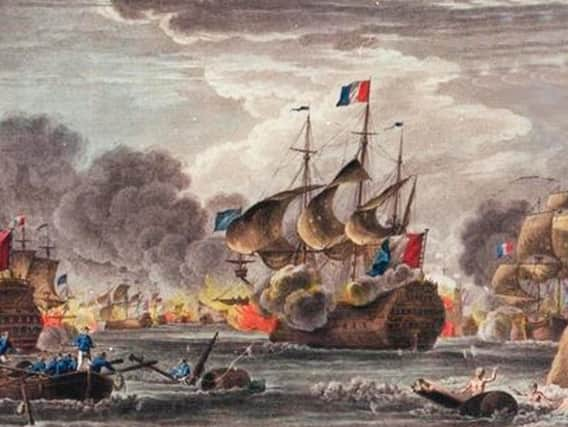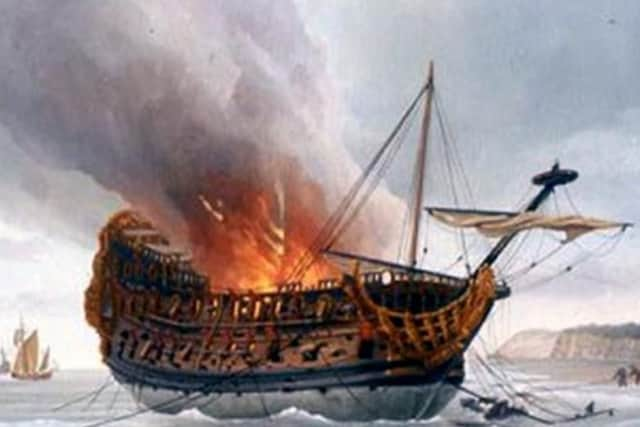French Admiral named Anne who sank HMS Anne off Sussex shore


Due to the ferocious storm they’d encountered, all the vessels were smashed to matchwood by the pounding surf and churning pebbles.
Other ships lost in the English Channel such as metal warships and submarines have left tangible remains but it is rare for wooden vessels to leave any long-term trace, the “Mary Rose” at Portsmouth being a notable exception. In Sussex we have the “Anne”. Not much of her, admittedly, yet enough to preserve her place in history just off the coast near Hastings.
Advertisement
Hide AdAdvertisement
Hide Ad“Anne” was a 70-gun warship built at Chatham Dockyard for the Royal Navy of King Charles II. The wood from some 2,300 trees went into her construction at a cost of £16,000 (around £1.6 million in today’s money). “HMS Anne” was launched in 1678.


The early history of the “Anne” is vague but the fact that King James II visited her in 1687 tells us she was named after James’ daughter, Anne. We also know that later that year the ship sailed to Lisbon ferrying a German princess to be married to Portugal’s King Pedro II.
“HMS Anne” saw her one and only action during the Nine Years’ War (1688-1697) fought between an alliance of Britain, Spain, Portugal, The Netherlands, Sweden and, for good measure, the Holy Roman Empire, all ranged against just a single enemy … France!
Louis XIV brought the war upon himself. Being acknowledged as the most powerful monarch in Europe was not enough for the “Sun King”; he was determined to accumulate more foreign possessions for France to reinforce his homegrown dynastic claims. The Nine Years’ War was fought from colonial North America to India and the Orient and in Europe embroiled Holland, the Rhineland and Spain. In effect this was a world war before the term world war had even been coined.
Advertisement
Hide AdAdvertisement
Hide AdSo where does the “Anne” rank in this global battleground? Well, to be frank, even though the Battle of Beachy Head is regarded as the greatest French maritime triumph in the whole of the conflict, it was really a rather modest affair in which the Dutch lost half a dozen warships and three fire ships while the English lost just one. The French under aptly named Admiral Anne-Hilarion, Comte de Tourville, went wholly unpunished. Considering the battle involved a combined total of 126 combatant vessels, the losses were small indeed.


That sole Royal Navy casualty was, of course, “HMS Anne”. She was not sunk by the French but did sustain serious damage. Rather than risk his crippled charge falling into enemy hands, Captain John Tyrell decided to set “Anne” on fire and run her aground. He was later lauded as having “withstood the violence of the whole French navy”. Doubtless Tyrell was a very gallant captain but I also suspect England sorely needed a hero to allay the whiff of defeat.
The battle came about after a French armada comprising 75 ships of the line mounting 4,600 guns together with 23 fire ships sailed eastwards into the English Channel in late June 1690. Their significantly smaller Anglo-Dutch adversaries mounted 4,153 guns. The English Admiral Arthur Herbert (1st Earl of Torrington) initially wanted to retreat and avoid a fight. He was over-ruled by Mary (wife of William of Orange) and her ministers who feared a French invasion.
On 10th July the fleets clashed south of Beachy Head. It was a muddled engagement; most of the Dutch ships lost were, like the “Anne”, actually set ablaze lest they be captured. The battle was ended late in the afternoon when Herbert cannily ordered his fleet to drop anchor. The unwary French were rendered aghast when they perceived how the tide and prevailing current was fast carrying their ships away and out of cannon range.
Advertisement
Hide AdAdvertisement
Hide AdAs soon as was prudent, the Allies weighed anchor and sailed for the sanctuary of the Thames estuary. They incurred no further losses. Even so, the reverse caused great panic in England with the Lewes-born diarist John Evelyn writing: “The whole nation now exceedingly alarmed by the French fleet braving our coast even to the very Thames mouth.”
Herbert later faced a court martial on charges of failing to support the Dutch navy. Though acquitted, King William sacked him anyway. French Admiral Anne-Hilarion was reprimanded for failing to exploit his initial success and he too was dismissed.
Meanwhile, in that same week, a truly momentous event was occurring elsewhere. William of Orange had landed in Ireland in pursuit of erstwhile King James II. The day after the Beachy Head fight saw William triumph at the Battle of the Boyne, a victory that secured him the British throne.
Defeated James blamed the absence of the French fleet in the Irish Sea for his troubles. A senior officer lamented: “The want of a squadron of French men-of-war in St. Georges Channel has been our ruin.” In short, though the Battle of Beachy Head was a defeat, the fact that the preceding campaign had tied up the French navy meant that William and his army could cross to Ireland unimpeded.
I’ll write more about the fate of the “Anne” along with the story of another Sussex wreck, that of “The Amsterdam”, in next week’s Yarns.